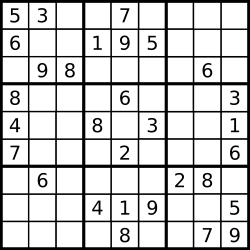三星机试也考了类似的题目,只不过是要针对给出的数独修改其中三个错误数字,总过10个测试用例只过了3个与世界500强无缘了
36. Valid Sudoku
Determine if a Sudoku is valid, according to: Sudoku Puzzles - The Rules.
The Sudoku board could be partially filled, where empty cells are filled with the character '.'.

A partially filled sudoku which is valid.
Note:
A valid Sudoku board (partially filled) is not necessarily solvable. Only the filled cells need to be validated.
Subscribe to see which companies asked this question
Idea
Just go through all you see (like "7 in row 3") and check for duplicates.
Solution 1
Using Counter. One logical line, seven physical lines.
def isValidSudoku(self, board):
return 1 == max(collections.Counter(
x
for i, row in enumerate(board)
for j, c in enumerate(row)
if c != '.'
for x in ((c, i), (j, c), (i/3, j/3, c))
).values() + [1])
The + [1] is only for the empty board, where max would
get an empty list and complain. It's not necessary to get it accepted here, as the empty board isn't among the test cases, but it's good to have.
Solution 2
Using len(set).
def isValidSudoku(self, board):
seen = sum(([(c, i), (j, c), (i/3, j/3, c)]
for i, row in enumerate(board)
for j, c in enumerate(row)
if c != '.'), [])
return len(seen) == len(set(seen))
Solution 3
Using any.
def isValidSudoku(self, board):
seen = set()
return not any(x in seen or seen.add(x)
for i, row in enumerate(board)
for j, c in enumerate(row)
if c != '.'
for x in ((c, i), (j, c), (i/3, j/3, c)))
Solution 4
Iterating a different way.
def isValidSudoku(self, board):
seen = sum(([(c, i), (j, c), (i/3, j/3, c)]
for i in range(9) for j in range(9)
for c in [board[i][j]] if c != '.'), [])
return len(seen) == len(set(seen))
Clean and Easy82ms Python
37. Sudoku Solver
Write a program to solve a Sudoku puzzle by filling the empty cells.
Empty cells are indicated by the character '.'.
You may assume that there will be only one unique solution.

A sudoku puzzle...

...and its solution numbers marked in red.
Subscribe to see which companies asked this question
最快的解决方案:
Sharing my 2ms C++ solution with comments and explanations.
Simple and Clean Solution / C++
13-line Python solution, dfs, beats 47.79%
参考文献:
http://www.cnblogs.com/felixfang/p/3705754.html